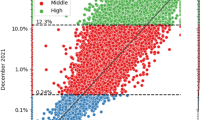Abstract
Social media content provides direct and indirect locational information. However, simply mapping media content such as Twitter posts will only provide a limited scope on the social media conversation. Assessing geotagged conversations needs to be combined with analyzing content and network structures including their dynamics. This research provides a set of structured methods towards filtering Twitter messages to remove unrelated content and better understand a public discussion. The approach is applied towards crowdsourced opinions on tanning in the United States and highlights that creating choropleth maps from unprocessed Twitter data will give a limited view on public health conversations. Cluster dendrograms and the network-focused Louvain unsupervised community detection algorithm were applied on a subset of over 25 million tanning related tweets, collected over a six week period. The research results show advertising and spamming clusters of tanning-related social media tweets, but also public discussions that relate to skin cancer and melanoma health concerns, fashion and beauty.
Zusammenfassung
Benutzer des Mediendienstes Twitter stellen bewusst und unbewusst eine Reihe von Informationen und Geodaten öffentlich zur Verfügung. Viele soziale Medienanalysen hat eine bedingte Aussagekraft, da die thematischen Visualisierungen häufig nur den Standort der verschickten Tweets darstellen. Eine wesentliche Anforderung ist die Entwicklung von Bereinigungsmechanismen für soziale Mediendaten sowie die Darstellung von Netzwerkstrukturen, Dynamiken, Interessensgemeinschaften und thematischen Schwerpunkten. Der vorliegende Beitrag zeigt wie mithilfe von Twitter-lnformationen die öffentliche Meinung und Diskussion zum Sonnenbräunen in den USA untersucht, werden kann. 25 Millionen Tweets wurden über einen Zeitraum von sechs Wochen zu diesem Thema gesammelt. Diese Daten wurden gefiltert, bereinigt und mithilfe von thematischen Karten, Dendrogrammen sowie netzwerkbasierten Analyseverfahren für Interessensgemeinschaften aufbereitet. Erste Ergebnisse zeigen, dass viele soziale Mediendaten durch Werbung und Spam verunreinigt sind. Nach dem Herausfiltern dieser Datensätze kann eine bessere Analyse der öffentlichen Diskussion zu Einstellung und Gefahren des Sonnenbräunens vorgenommen werden. Dieser Beitrag zeigt neue Forschungspotenziale innerhalb der Kartographie auf sowie interdisziplinäre Entwicklungsanforderungen zur besseren Analyse von sozialen Mediendaten.
Similar content being viewed by others
References
Blondel, V, Guillaume, J. L., Lambiotte, R. and Lefebvre, E. (2008) “Fast unfolding of community hierarchies in large networks” Journal of Statistical Mechanics: Theory and Experiment (10), P10008(12pp)
Crampton, J. W., Graham, M., Poorthuis, A., Shelton, T., Stephens, M., Wilson, M. and Zook, M. (2013) “Beyond the geotag: situating ‘big data’ and leveraging the potential of the geoweb.” Cartography and geographic information science 40, no. 2: 130–139
Croitoru, A., Stefanidis, A., Radzikowski, J., Crooks, A., Stahl, J. and Wayant, N. (2012) “Towards a collaborative geosocial analysis workbench” Proceedings of the 3rd International Conference on Computing for Geospatial Research and Applications, 18
Croitoru, A., Crooks, A., Radzikowski, J. and Stefanidis, A. (2013) “Geosocial gauge: a system prototype for knowledge discovery from social media”, International Journal of Geographical Information Science, Vol. 27, No. 12, 2483–2508
Croitoru, A., Wayant, N., Crooks, A., Radzikowski, J. and Stefanidis, A. (2015) “Linking Cyber and Physical Spaces Through Community Detection And Clustering in Social Media Feeds” Computers, Environment and Urban Systems
Croitoru, A., Crooks, A., Radzikowski, J. and Stefanidis, A. (2015a) Richardson, D.; Castree, N.; Goodchild, M. F.; Kobayashi, A. L; Liu, W. and Marston, R. (Eds.) “The International Encyclopedia of Geography: People, the Earth, Environment, and Technology”, Chapter “Geovisualization of Social Media”, Wiley Blackwell
Fabrikant, S. I. and Buttenfield, B. P. (1997) “Envisioning User Access to a Large Data Archive” Proceedings, GIS/ LIS, 97, Cincinnati, OH, Oct. 28–30: 686–692
Fabrikant, S. I. (2000) “Spatialized Browsing in Large Data I Archives” Transactions in GIS, vol. 4, no. 1: 65–78
Friedland, G. and Sommer, R. (2010) “Cybercasing the joint: On the privacy implications of geotagging” Proceedings of the Fifth USENIX Workshop on Hot Topics I in Security (HotSec 10), Washington, D. C
Fritz, S., MacCallum, I., Schill, C, Perger, C., Grillmayer, R., Achard, F., Kraxner, F. and Obersteiner, M. (2009) “Geo-Wiki. Org: The Use of Crowdsourcing to Improve Global Land Cover” Remote Sensing, 1 (3): 345–354
Goodchild, M. F (2007) “Citizens as Sensors: The World of Volunteered Geography”, GeoJournal. 69 (4): 211–221
Harvey, F. (2013) Sui, D., Elwood, S., Goodchild, M. (Eds.), “Crowdsourcing Geographic Knowledge”, Chapter “To Volunteer or to Contribute Locational Information? Towards Truth in Labeling for Crowdsourced Geographic Information”, Springer Netherlands, pp. 31–42, doi: 10.1007I978-94-007-4587-2J
Kaplan, A. M. and Haenlein, M. (2010) “Users of the World unite! The challenges and opportunities of social media” Business Horizons 53:59–68
Lazovich, D., Vogel, R. I., Berwick, M., Weinstock, M. A., Anderson, K. E., Warshaw, E. M. (2010) “Indoor tanning and risk of melanoma: a case-control study in a highly exposed population” Cancer Epidemiology, Biomarkers & Prevention. 19 (6):1557–1568
MacEachren, A. M., Robinson, A. C, Jaiswal, A., Pezanowski, S., Savelyev, A., Blanford, J. and Mitra, P. (2011) “Geo-Twitter Analytics: Applications in Crisis Management”, Proceedings of the 25th International Cartographic Conference, Paris, France
Nelson, J., Quinn, S., Swedberg, B., Chu, W. and MacEachren, A. (2014) “Geovisual Analytics Approach to Exploring Public Political Discourse on Twitter” ISPRS Int. J. Geo-Inf. 4 (1), 337–366
Purdue, M. P., Freeman, L. E. B., Anderson, W. F. and Tucker, M. A.(2008) “Recent trends in incidence of cutaneous melanoma among US Caucasian young adults” Journal of Investigative Dermatology. 128 (12): 2905–2908
Stefanidis, A., Crooks, A. and Radzikowski, J. (2013) “Harvesting ambient geospatial information from social media feeds” GeoJournal, Springer, 78 (2), 319–338
U.S. Department of Health and Human Services (2014) “The Surgeon General’s Call to Action to Prevent Skin Cancer” Washington, D. C: U.S. Dept of Health and Human Services, Office of the Surgeon General; 2014.
U.S. Food and Drug Administration (2014) FDA news release: “FDA to require warnings on sunlamp products.” U.S Food and Drug Administration website. http://www.fda.gov/NewsEvents/Newsroom/Press Announcements/ucm399222.htm. Accessed January 20, 2015.
Author information
Authors and Affiliations
Rights and permissions
About this article
Cite this article
Radzikowski, J.R., Hollen, H. & Fuhrmann, S. Using Twitter Content to Crowdsource Opinions on Tanning in the United States. j. Cartogr. Geogr. inf. 65, 131–138 (2015). https://doi.org/10.1007/BF03545117
Received:
Accepted:
Published:
Issue Date:
DOI: https://doi.org/10.1007/BF03545117




